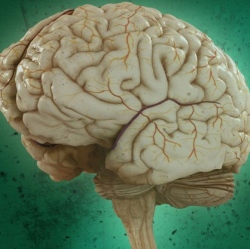
Scientists studying brain process involved in sight have discovered that the visual cortex also uses information gleaned from the ears when viewing the world. They suggest this auditory input enables the visual system to predict incoming information and could confer advantages.
“Sounds create visual imagery, mental images, and automatic projections,” said Professor Lars Muckli, of the University of Glasgow’s Institute of Neuroscience and Psychology, who led the research. “For example, if you are in a street and you hear the sound of an approaching motorbike, you expect to see a motorbike coming around the corner.”
The study, published in the journal Current Biology (open access), involved conducting five different experiments using functional Magnetic Resonance Imaging (fMRI) to examine the activity in the early visual cortex in 10 volunteer subjects.
In one experiment they asked the blindfolded volunteers to listen to three different sounds: birdsong, traffic noise and a talking crowd. Using a special algorithm that can identify unique patterns in brain activity, the researchers were able to discriminate between the different sounds being processed in early visual cortex activity. A second experiment revealed that even imagined images, in the absence of both sight and sound, evoked activity in the early visual cortex.
